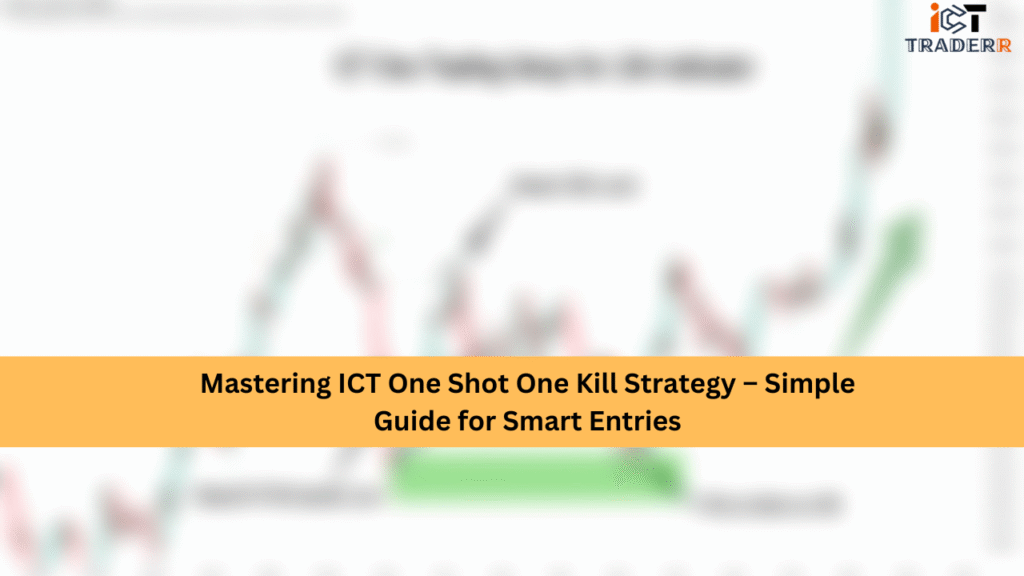When you’re serious about Forex trading and aiming for big gains with fewer trades, ICT One Shot One Kill is a strategy you want to learn. Crafted on the Smart Money Concept, it lets you track institutional moves and time your trades perfectly. In this guide, I’ll walk you through why this method works, how you set it up, and ways to protect your capital — all in clear, modern terms.

What Is the ICT One Shot One Kill Strategy?
Think of it like a sniper’s shot — precise, powerful, and timed perfectly. Instead of scattering shots across the screen, you focus on a single high-conviction trade. This means:
- One smart entry, not dozens of small guesses
- Clear signals to enter and exit — no guesswork
- Optimized risk-to-reward, aiming for a bigger payoff per trade
By focusing on quality over quantity, you reduce noise and mental stress while giving yourself room to focus on real opportunities.
Smart Money Concept Behind This Strategy
The Smart Money Concept (SMC) is a foundational element of this strategy. Here’s how it matters:
- Institutional Movements: Big banks and hedge funds leave footprints — zones where they accumulate or distribute positions. ICT strategy teaches you to identify and follow these footprints.
- Liquidity Hunting: Smart Money often sweeps stop-loss zones before reversing the price. ICT helps you avoid traps and ride the actual move.
- Order Blocks & Fair Value Gaps: These zones show where big players entered, creating potential reversal zones. You’ll learn to time entries when prices test or reject these levels.
By following what “smart money” is doing, you move in alignment with the big players — and that’s where consistent gains happen.
Ideal Market Conditions for One Shot One Kill
Before lining up your trade, check if conditions are right:
- Low-volatility sessions: This strategy shines when you trade at London or New York starts, when volume is high.
- Clean trend structure: Look for clear swing highs and lows, support and resistance zones, and an unbroken market structure.
- Confluence: Price touching an order block, liquidity sweep, and a key session open — this alignment creates a high-probability setup.
If any one of these is missing, skip the trade. Remember: quality entry beats quantity.
Step-by-Step Breakdown of the Setup
Here’s how you set it up, from screen to execution:
- Mark order blocks: Locate the last bullish or bearish candle before a strong directional move. Draw a zone around it — that’s your price area.
- Identify liquidity sweep: Spot areas where price spikes below support or above resistance, then reverses quickly. This signals a stop-hunt.
- Wait for return: Let the price revisit the order block. This gives you a second bite at the apple.
- Watch for a precise entry candle: Look for a pin-bar, engulfing candle, or other strong rejection signal within that order block.
- Enter: Enter at the close of the rejection candle or break of its high/low, whichever aligns with the price movement.
- Define risk clearly: Place your stop-loss just beyond the order block and liquidity sweep — tight, logical, and safe.
- Plan your take-profit: Use recent swing highs/lows or a 2:1 reward-to-risk ratio. If conditions support more, stretch to 3:1.
Stop-Loss, Risk Management & Trade Management
Your trade is only as good as your risk plan:
- Position size: Risk no more than 1–2% of your account per trade.
- Stop placement: Just below or above the order block and liquidity sweep — never wider than necessary.
- TP Strategy:
- Enter partial take-profit at visible swing levels.
- Move stop to breakeven once your trade is up 1. R.
- Let profits run to your full TP, or trail under structure shifts
- Enter partial take-profit at visible swing levels.
- Never chase: If price zooms past your entry without signal, let it go. You’ll wait for the next high-quality setup.
Common Mistakes to Avoid
Even the best strategy fails if not applied properly. Here’s where you should be cautious:
- Diving in too early: Wait for confirmation candles inside your order block.
- Ignoring session context: A setup in low-volume times often fails.
- Setting stops too tight or wide: Find balance — just beyond natural structure, not a random distance.
- Overtrading: A Smart strategy means few entries. Resist the urge to force signals.
- Ignoring risk/reward: A 1:1 trade hurts profits — aim for 2:1 or more consistently.
Conclusion
ICT One Shot One Kill is your key to disciplined, smart Forex trading. It teaches you to:
- Spot Smart Money zones
- Time entries with precision
- Manage trades and capital like a pro..
Remember: less noise, higher quality, and you stay in sync with market movers. Over time, this method builds real edge and confidence, not just random profits.
FAQs
What timeframes work best for this strategy?
Ideal for 1H, 4H, and Daily charts. Lower timeframes can produce trading noise and false signals.
Do I need indicators?
Not really. This method leans on pure price action, order blocks, liquidity, and structure. If you prefer filters, consider volume or session pivots — but keep it minimal.
Can I automate parts of it?
Some traders semi-automate pattern alerts, but full automation is tricky. The art lies in your judgment — you’re the sniper here.
How do I heal from a losing streak?
Stick to your rules. Review your setups, track mistakes, and deliberately refine your process. One well-managed trade can make up for several small losses.
Is it suitable for beginners?
Yes — but you’ll need patience. Master the zone-marking before risking real money. Demo trading these setups helps you learn discipline without emotional pressure.



